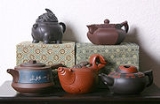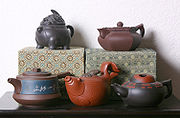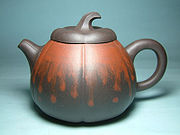
Yixing clay
Encyclopedia

Yixing
Yixing is a county-level city in Jiangsu province, in eastern China with a population of 1.3 million. It is well-known for its Yixing clay and the pottery -- especially the "zisha"-style teapots -- made from the clay...
in Jiangsu
Jiangsu
' is a province of the People's Republic of China, located along the east coast of the country. The name comes from jiang, short for the city of Jiangning , and su, for the city of Suzhou. The abbreviation for this province is "苏" , the second character of its name...
province, China
China
Chinese civilization may refer to:* China for more general discussion of the country.* Chinese culture* Greater China, the transnational community of ethnic Chinese.* History of China* Sinosphere, the area historically affected by Chinese culture...
. Its use dates back to the Song Dynasty
Song Dynasty
The Song Dynasty was a ruling dynasty in China between 960 and 1279; it succeeded the Five Dynasties and Ten Kingdoms Period, and was followed by the Yuan Dynasty. It was the first government in world history to issue banknotes or paper money, and the first Chinese government to establish a...
(960 - 1279) when purple clay was first mined around Lake Taihu in China. From the 17th century on, the ware was commonly exported
Chinese export porcelain
Chinese export porcelain concerns a wide range of porcelain that was made and decorated in China exclusively for export to Europe and later to North America between the 16th and the 20th century.-Early China porcelain trade:...
to Europe
Europe
Europe is, by convention, one of the world's seven continents. Comprising the westernmost peninsula of Eurasia, Europe is generally 'divided' from Asia to its east by the watershed divides of the Ural and Caucasus Mountains, the Ural River, the Caspian and Black Seas, and the waterways connecting...
. The finished stoneware
Stoneware
Stoneware is a vitreous or semi-vitreous ceramic ware with a fine texture. Stoneware is made from clay that is then fired in a kiln, whether by an artisan to make homeware, or in an industrial kiln for mass-produced or specialty products...
, which is used for teaware
Teaware
Teaware encompasses a broad international spectrum of equipment used in the brewing and consumption of tea. Many components make up that spectrum, and vary greatly based upon the type of tea being prepared, and the cultural setting in which it is bring prepared...
and other small items, are usually red or brown in color. They are known as Purple Sand ware, and are typically unglazed. The sandy clays used for the yixing-wares are very cohesive and can be formed by slip molding, coil forming, or most commonly, slab forming. The clays can also be formed by throwing. The most famous wares made for yixing clay are Yixing clay teapot
Yixing clay teapot
Yixing clay teapots Yixing clay teapots Yixing clay teapots (also called Purple Sand are made from Yixing clay. This traditional style commonly used to brew tea originated in China, dating back to the 15th century, and are made from clay produced in the region of the town of Yixing in the...
s (宜興紫砂壺; yíxīng zǐshā hú - Yixing Purple Sand Pot).
Types

- Zisha or Zini (紫砂 or 紫泥 ; literally, "purple sand/clay"): this stoneware has a purple-red-brown color.
- Zhusha or Zhuni (朱砂 or 朱泥; literally, "cinnabarCinnabarCinnabar or cinnabarite , is the common ore of mercury.-Word origin:The name comes from κινναβαρι , a Greek word most likely applied by Theophrastus to several distinct substances...
sand/clay"): reddish brown stoneware with a very high iron content. The name only refers to the sometimes bright red hue of cinnabar (朱砂; pinyin: zhūshā). There are currently 10 mines still producing zhuni . However, due to the increasing demand for Yixing stoneware, zhuni is now in very limited quantities. Zhuni clay is not to be confused with hongni (红泥, literally, "red clay", another red clay. - Duanni (鍛泥; literally, "fortifed clay"): stoneware that was formulated using various stones and minerals in addition to zini or zhuni clay. This results in various textures and colours, ranging from beige, blue, and green (绿泥), to black.
Mineral composition
Chemically, Zisha is a mixture of kaolin, quartzQuartz
Quartz is the second-most-abundant mineral in the Earth's continental crust, after feldspar. It is made up of a continuous framework of SiO4 silicon–oxygen tetrahedra, with each oxygen being shared between two tetrahedra, giving an overall formula SiO2. There are many different varieties of quartz,...
and mica
Mica
The mica group of sheet silicate minerals includes several closely related materials having highly perfect basal cleavage. All are monoclinic, with a tendency towards pseudohexagonal crystals, and are similar in chemical composition...
, with a high content of iron oxide
Iron oxide
Iron oxides are chemical compounds composed of iron and oxygen. All together, there are sixteen known iron oxides and oxyhydroxides.Iron oxides and oxide-hydroxides are widespread in nature, play an important role in many geological and biological processes, and are widely utilized by humans, e.g.,...
. It is mined principally at Huanglongshan and Zhaozhuangshan and has a somewhat sandy texture. The process of preparing the clay is lengthy and was traditionally regarded as a trade secret. Typical firing temperature is between 1100C - 1200C, higher than regular clay, in an oxidizing atmosphere.
Manufacturing
The raw materials for yixing clay are buried deep underground, sometimes under heavy sedimentary rockSedimentary rock
Sedimentary rock are types of rock that are formed by the deposition of material at the Earth's surface and within bodies of water. Sedimentation is the collective name for processes that cause mineral and/or organic particles to settle and accumulate or minerals to precipitate from a solution....
formations. When excavated, it is usually located within stratified layers of other clays. The seam of yixing zisha can be as thick as a several decimeters, up to a meter. Yixing clays consist of fine iron
Iron
Iron is a chemical element with the symbol Fe and atomic number 26. It is a metal in the first transition series. It is the most common element forming the planet Earth as a whole, forming much of Earth's outer and inner core. It is the fourth most common element in the Earth's crust...
-containing silt, with mica
Mica
The mica group of sheet silicate minerals includes several closely related materials having highly perfect basal cleavage. All are monoclinic, with a tendency towards pseudohexagonal crystals, and are similar in chemical composition...
, kaolinite
Kaolinite
Kaolinite is a clay mineral, part of the group of industrial minerals, with the chemical composition Al2Si2O54. It is a layered silicate mineral, with one tetrahedral sheet linked through oxygen atoms to one octahedral sheet of alumina octahedra...
and varying quantities of quartz
Quartz
Quartz is the second-most-abundant mineral in the Earth's continental crust, after feldspar. It is made up of a continuous framework of SiO4 silicon–oxygen tetrahedra, with each oxygen being shared between two tetrahedra, giving an overall formula SiO2. There are many different varieties of quartz,...
and iron ores as its main mineral constituents.
Processing of raw zisha yixing clay involves removing the clay from the underlying strata, drying it under the sun in open stalls, and then pulverizing the dried clay pieces into fine particles. The clay powder then undergoes air screening to isolate clay particles of the finest grit size. The screened clay is then mixed with water in a cement mixer
Cement mixer
A cement mixer is a shot drink. It often consists of:*1 part Bailey's Irish Cream *1 part Lime juice...
to a thick paste, piled into heaps, and vacuum processed to remove air bubbles, in addition to some moisture from the clay mixture. The quality and quantity of water in yixing clay is critical in that it determines the quality of the stoneware products produced. After this processing, the resulting clay is then ready to be used.
The appearance of yixing products, such as its colour or texture, can be enriched and altered through the addition of various metal oxide
Oxide
An oxide is a chemical compound that contains at least one oxygen atom in its chemical formula. Metal oxides typically contain an anion of oxygen in the oxidation state of −2....
s into the yixing clay, through the manipulation of firing temperatures, and also from regulating the kiln atmosphere (oxidative versus reductive).
Use
Yixing teawares are prized because their unglazed surfaces absorb traces of the beverage, creating a more complex flavour. For these reasons, yixing teawares should never be washed using detergents, but rather with water only, and connoisseurs recommend using each tea vessel for one kind of tea (white, green, oolong, or black) or sometimes even one variety of tea only.Early pots were designed for travel use hence you will see the simple classical look of the pots produced during the Ming Dynasty. Most tea drinking enthusiast will have one teapot for travel use, these tend to be less expensive and compact in design. It was not until during the mid-Qing Dynasty (18th century) that tea connoisseurs started to use the pot at home and the artisan begin to form them into different shape and sizes. Many exotic forms were conceived. Vessels were decorated with poetic inscriptions, calligraphy, paintings and seals were incised onto the surface of the teapots.
External links
- 紫砂博客网
- Yixing City English Guide (Jiangsu.Net)

